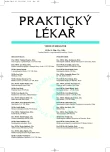A successful cure of atypic hemolytic-uremic syndrome
Authors:
J. Pták 1; L. Rožnovský 2; J. Zunická 1; A. Zjevíková 2
Authors‘ workplace:
Krevní centrum Fakultní nemocnice s poliklinikou Ostrava
primářka MUDr. Zuzana Čermáková
1; Klinika pro léčbu chorob infekčních a AIDS
přednosta MUDr. Luděk Rožnovský, CSc.
2
Published in:
Prakt. Lék. 2006; 86(6): 343-346
Category:
Case Report
Overview
In the article, the case of a young woman is described who was admitted to hospital with a fever, pharyngitis, jaundice and dyspepsia with suspected viral hepatitis or infectious mononucleosis. Blood analysis and biochemical analysis indicated signs of microangiopathic hemolytic anemia and the beginnings of renal failure. The diagnosis of hemolytic-uremic syndrome was determined and treatment by therapeutic plasma exchange was started. For substitution, fresh frozen plasma was used. The intervals between plasma exchanges were 24 hours. Corticoids were applied as well. Eight plasma exchanges were performed in total: 7 plasma exchanges were performed at 24 hour intervals and the eighth after four days. During this period the thrombocyte count reached a normal value, the hemolysis stopped and the renal functions returned to normal. Through examination of the ADAMTS 13 metaloprotease level, diagnosis of thrombotic thrombocytopenic purpura was excluded. Using present-day diagnostic tests, it was not possible to determine if this condition could be interpreted as a relapse of the hereditary disease brought on through genetic mutation or as the secondary hemolytic-uremic syndrome related to respiratory infection. Because of the interval of 25 years between the first signs of illness in childhood (Gasser’s syndrome) and the present signs of disease, we assumed, that the secondary form of hemolytic-uremic syndrome related to respiratory infect was more likely.
Key words:
hemolytic-uremic syndrome, plasmapheresis
Labels
General practitioner for children and adolescents General practitioner for adultsArticle was published in
General Practitioner

2006 Issue 6
Most read in this issue
- The harmful effect of noise on the human organism
- Inhaled insulin
- Pulmonary embolism in the pneumology out-patient clinic
- Why and what kind of physical training is most effective for health and quality of life in older persons?
